Banda Bimble

|
Banda
Bimble
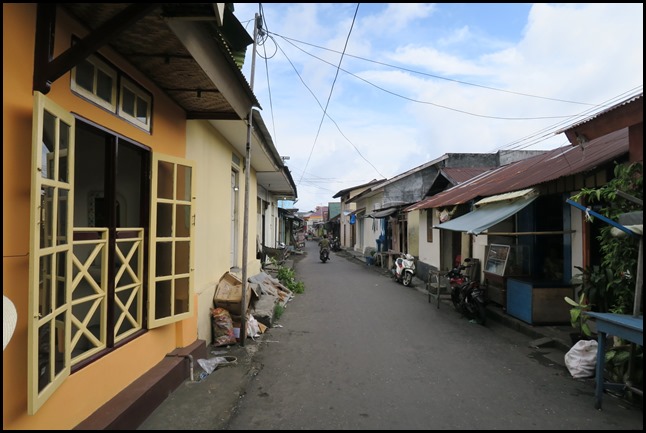 After
lunch we were ready to explore. The High Street walking toward the
fish market.
Wiki
says: The Banda Islands are
a volcanic
group of
ten small volcanic
islands in
the Banda
Sea,
about 140 km (87 miles) south of Seram
Island and
about 2,000 km (1,243 miles) east of Java,
and are part of the Indonesian province
of Maluku.
The main town and administrative centre is Banda
Neira,
located on the island of the same name. They rise out of 4-to-6-kilometre (2.5
to 3.7 miles) deep ocean and have a total land area of approximately 180 square
kilometres (69 square miles). They have a population of about 15,000. Until the
mid-19th century the Banda Islands were the world's only source of the
spices nutmeg and
mace,
produced from the nutmeg tree. The islands are also popular destinations
for scuba
diving and
snorkeling.
 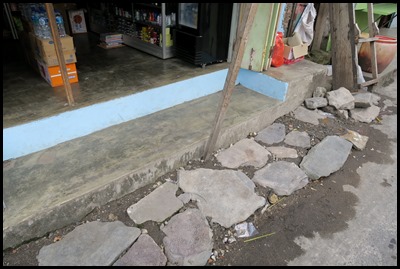 A typical
shop with crazy-paving entrance.
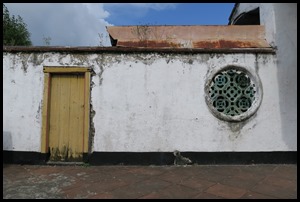 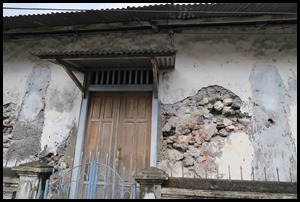  Crumbling
memories of when the Dutch were based here during the spice
heyday.
Wiki Says: Until the mid-19th century, the small island group of the Banda Islands, which are also known under the name 'Spice Islands’, was the only location of the production of the spices nutmeg and mace in the world. Nutmeg is known to have been a prized and costly spice in European medieval cuisine as a flavouring, medicinal, and preservative agent. Saint Theodore the Studite (c. 758 – 826) allowed his monks to sprinkle nutmeg on their pease pudding when required to eat it. In Elizabethan times, because nutmeg was believed to ward off the plague, demand increased and its price skyrocketed. Nutmeg was known as a valuable commodity by Muslim sailors from the port of Basra (including the fictional character Sinbad the Sailor in the One Thousand and One Nights). Nutmeg was traded by Arabs during the Middle Ages and sold to the Venetians for high prices, but the traders did not divulge the exact location of their source in the profitable Indian Ocean trade, and no European was able to deduce its location. The Banda Islands became the scene of the earliest European ventures in Asia, in order to get a grip on the spice trade. In August 1511, Afonso de Albuquerque conquered Malacca, which at the time was the hub of Asian trade, on behalf of the king of Portugal. In November of the same year, after having secured Malacca and learning of Banda's location, Albuquerque sent an expedition of three ships led by his friend António de Abreu to find it. Malay pilots, either recruited or forcibly conscripted, guided them via Java, the Lesser Sundas, and Ambon to the Banda Islands, arriving in early 1512. The first Europeans to reach the Banda Islands, the expedition remained for about a month, buying and filling their ships with Banda's nutmeg and mace, and with cloves in which Banda had a thriving entrepôt trade. An early account of Banda is in Suma Oriental, a book written by the Portuguese apothecary Tomé Pires, based in Malacca from 1512 to 1515. Full control of this trade by the Portuguese was not possible, and they remained participants without a foothold in the islands. In order to obtain a monopoly on the production and trade of nutmeg, the Dutch East India Company (VOC) waged a bloody battle with the Bandanese in 1621. Historian Willard Hanna estimated that before this struggle the islands were populated by approximately 15,000 people, and only 1,000 were left (the Bandanese were killed, starved while fleeing, exiled or sold as slaves). The Company constructed a comprehensive nutmeg plantation system on the islands during the 17th century. It included the nutmeg plantations for spice production, several forts for the defence of the spices, and a colonial town for trading and governance. The Dutch were not the only occupants of this region, however. The British skilfully negotiated with the village leaders on the island Rhun to protect them from the Dutch in exchange for a monopoly on their nutmeg. The village leader of Rhun accepted King James I of England as their sovereign, and it became the first overseas English colony. Control of the Banda Islands continued to be contested until 1667 when, in the Treaty of Breda, the British ceded Rhun to the Dutch in exchange for the island of Manhattan and its city New Amsterdam (later New York) in North America. As a result of the Dutch interregnum during the Napoleonic Wars, the British took temporary control of the Banda Islands from the Dutch and transplanted nutmeg trees, complete with soil, to Sri Lanka, Penang, Bencoolen, and Singapore. (There is evidence that the tree existed in Sri Lanka even before this.) From these locations they were transplanted to their other colonial holdings elsewhere, notably Zanzibar and Grenada. The national flag of Grenada, adopted in 1974, shows a stylised split-open nutmeg fruit. The Dutch retained control of the Spice Islands until World War II. Connecticut received its nickname ("the Nutmeg State", "Nutmegger") from the claim that some unscrupulous Connecticut traders would whittle "nutmeg" out of wood, creating a "wooden nutmeg", a term which later came to mean any type of fraud.
Seeds drying on a porch as the sparrows help themselves.
 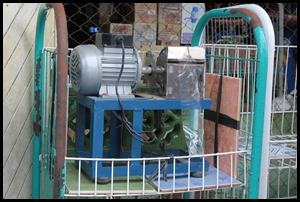  Everything including the kitchen sink. A cassava
grater and a saw shop.
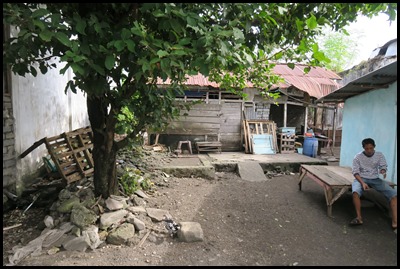 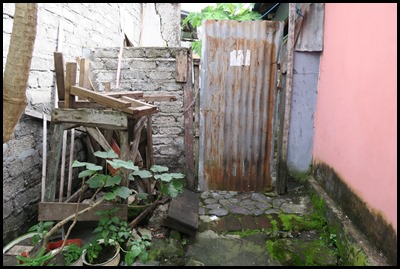 Back yards.
  We turned right at a well stocked shoe shop and passed some semi-detached chicken houses.
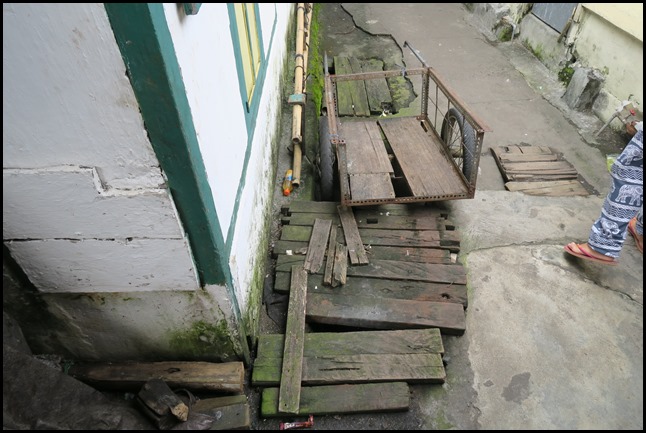 Looking down on the uneven surfaces is a must.
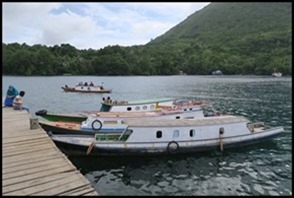   Down on the small
boat wharf people were relaxing.
 A local ferry went
by.
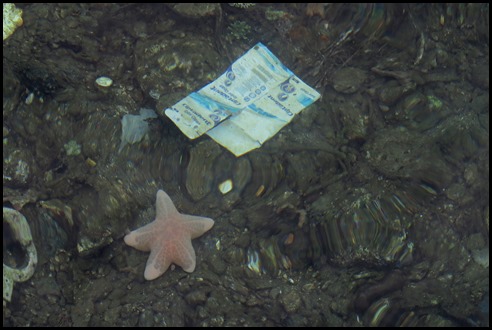 Despite rubbish and corn shucks the
water was clear and we saw a healthy looking
starfish.
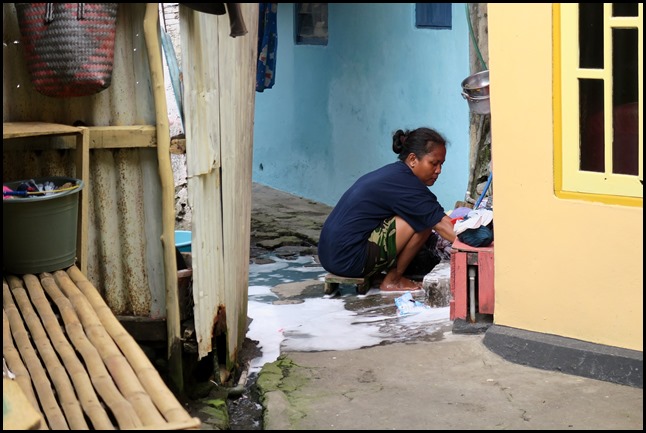 We turned right and bimbled on. Wash day for this lady.
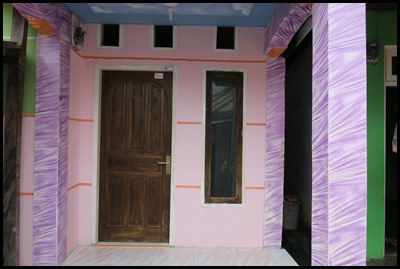  Not Berger paint but tiles on
these bright houses.
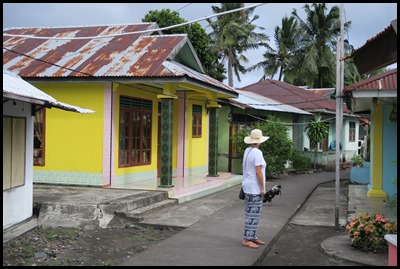 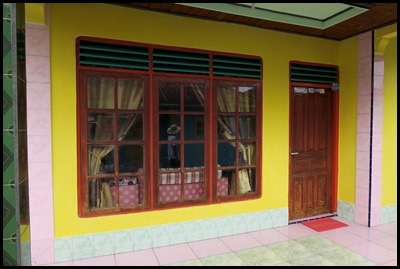 Catherine
(Afar VI) meets a chicken and her hat reflects in the window of a
yellow and pink house.
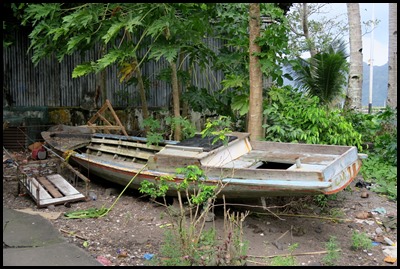 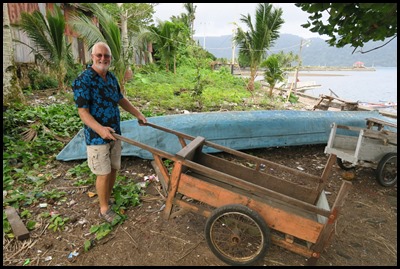 A ‘One Carefully Owned’ boat and cart.
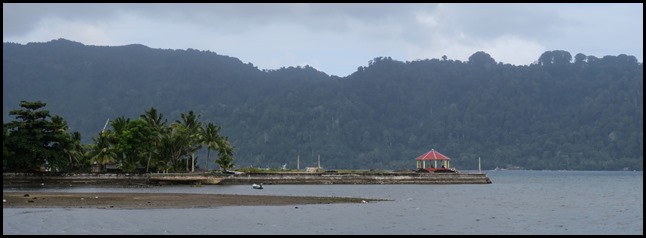 Our view at the
edge of our bimble. The sky looks heavy with the threat of
rain.
  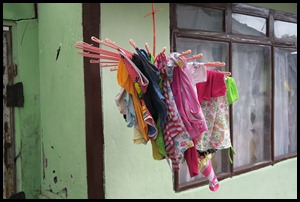 We made our way back via the bank that
was kind enough to give Bear money at the hole in the wall. Each turn brought
new and colourful images.
 A man enjoying some afternoon Zzzz’s.
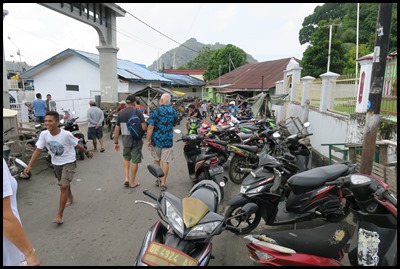 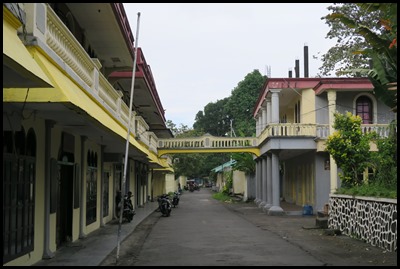 The High Street now resembled a bike park. Back to base in time
for a Sprite before the evenings entertainment and buffet. Chance to watch the
reason for all the activity – a delivery boat was in
on the wharf.
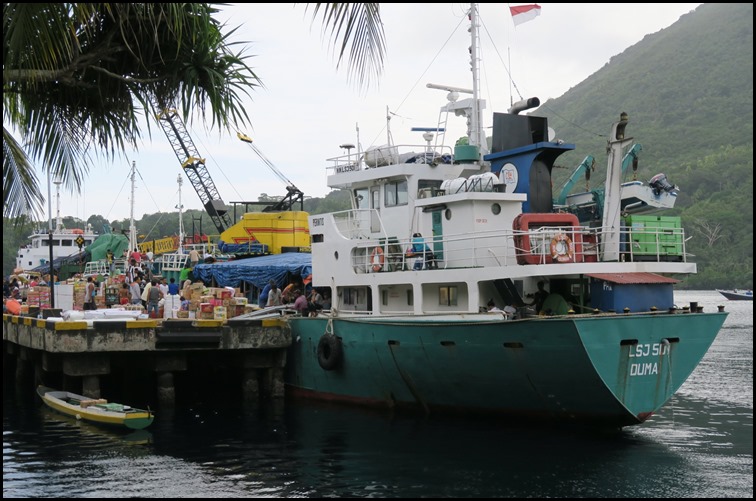 ALL IN ALL A WONDERFUL BIMBLE
NEAT
BUILDINGS |
